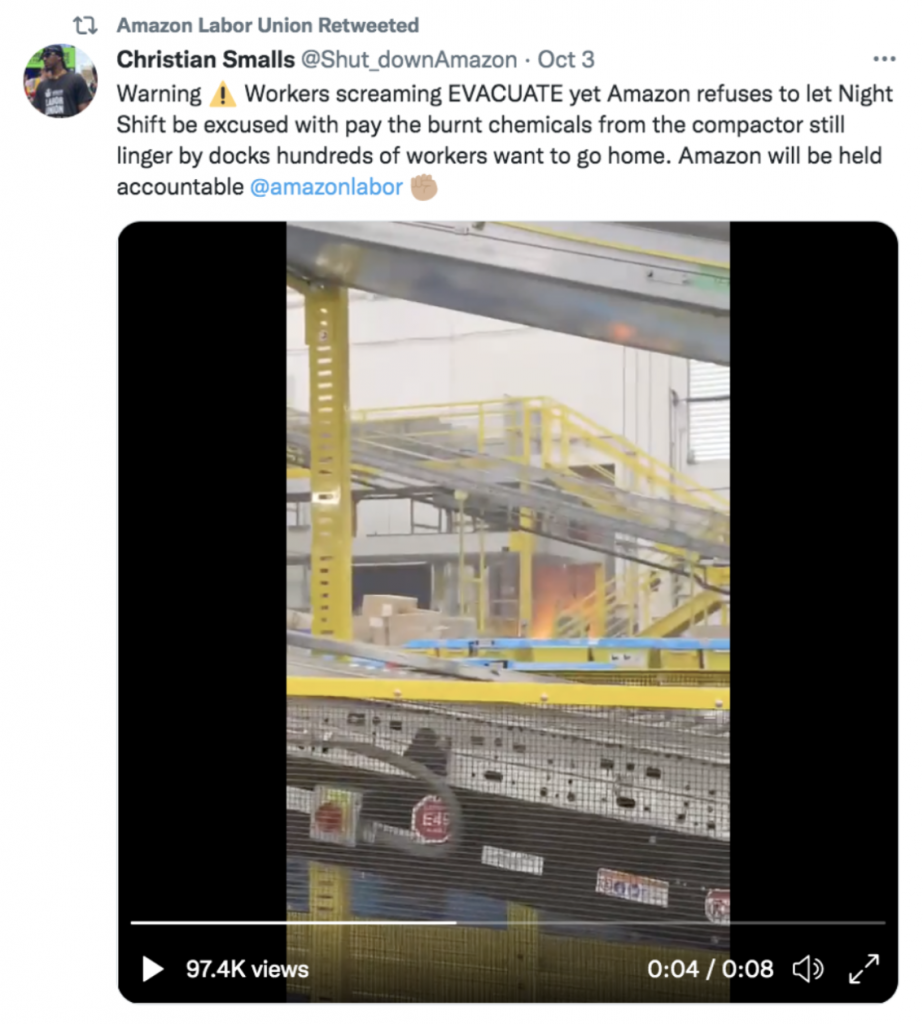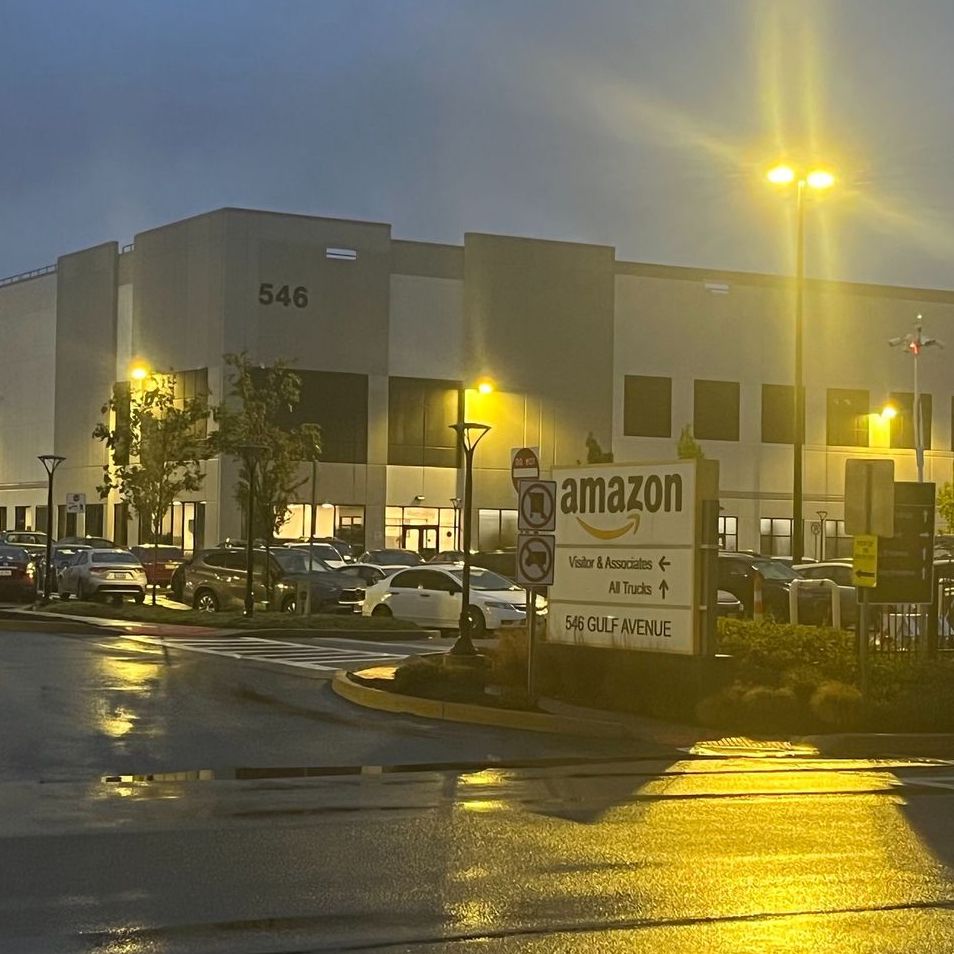In the late afternoon on October 3rd, a fire occurred at the sorting centre at JFK8 warehouse in Staten Island. This started when a cardboard-box compactor caught fire by a loading dock which occurred near the shift changeover. The company refused to allow the evening shift (beginning at 5:45 PM) to take off from work, even after they expressed health concerns and demanded to go home with Paid time off (PTO).
As a result 650 workers entered the break room and another group entered the HR department, demanding they not be subject to unsafe working conditions. This resulted in 80 workers being suspended by the company in an act of clear anti union retaliation. Not only was this fire totally preventable, but the company refused to aid these workers in health care or compensation. But this repression represents a long history of the company refusing to uphold safety protocols, risking workers’ lives in order to secure maximum profit.

Around 4:00 PM, workers reported a fire from a compactor on the loading dock of building JFK8. Employees could be seen on video screaming “Evacuate” while running away from the blaze. At the same time Amazon told workers to exit through the turnstiles instead of the fire exits, which could endanger and trap workers inside the building. Yet the company still refuses the night shift’s request to go home because it would mean sacrificing continuous profit from employees’ labor.
After this initial stage, the evacuated employees were made to stand around in cold 50 degree rain in the parking lot for an hour, while FDNY rushed to the scene. Once the initial fire was cleared, the day-shift workers were allowed to leave an hour early with pay.
But the company announced that all evening workers must report to work, saying the warehouse was deemed safe. Later, Amazon management would claim that once the fire was removed, only a small group had refused to work, reporting “Yesterday afternoon there was a small fire in a cardboard compactor outside of JFK8, one of our facilities in Staten Island, New York,” an Amazon spokesperson wrote. “All employees were safely evacuated, and day shift employees were sent home with pay. The FDNY certified the building is safe and at that point we asked all night shift employees to report to their regularly scheduled shift. While the vast majority of employees reported to their workstations, a small group refused to return to work and remained in the building without permission.”
However, in response to this dangerous situation, workers on the ground say that as many as 650 workers at JFK8 sat in the break room demanding they be sent home, stating that the working environment was dangerous for their health, as they could still smell toxic chemicals and fumes in the warehouse, a clear safety hazard.
After a few hours, Amazon demanded workers go back to work and leave the break room, but many stayed behind to protest the unfair treatment. Additionally, at around 9pm, about 100 of those employees did a “march on the boss,” going to the HR office and demanding night shift be sent home with pay. The fire itself was an avoidable event, had the company investigated the danger of the compactor.
As stated by Amazon labor Union lawyer Seth Goldstein, the compactor had been causing problems and smoking for weeks in the warehouse. What was Amazon’s solution to this clear hazard to workers safety? The multibillion dollar company had been pouring water on the compactor to stop the smoke. They could have prevented this risk to employees’ health by evaluating the compactor, but this delay would be impossible because it would cut into valuable profit.
How did the company respond?
After the strike ended, 80 workers were suspended from their positions at Amazon, even though their safety was put at risk. These workers are being deemed “under investigation” for simply speaking up about safety hazards. These suspensions were done haphazardly, and seem to be targeted and malicious, not only full of anti-union animus, but also other forms of bigotry.
In fact, one worker has reported that while all the women in her department who participated were suspended, none of the men were! The company has also tried to obfuscate the safety concerns of the workers and downplay the necessity for union activity. When the employees walked into the break room as an act of protest, the company underestimated how many employees were involved in the walk out. Chris Smalls, the president of ALU stated that the number of employees who went to the break room and refused to return to work was 650, compared to the meagre 100 reported by the company.
The company tried to minimise how many workers refused to return to work after the fire. The company initially stated that a ‘small’ group of workers refused to go to work after the fire. But the truth is that this percentage of dissatisfied workers was much larger, with many employees feeling unsafe being exposed to toxic chemicals and smoke inhalation within the warehouse. Although the company states that it was a small group of workers participating in the strike, the reality was that a large percentage of employees felt unsafe. As the ALU stated, “The ‘small group’ that refused to return to work made up 30% of the building by management’s own admission.”
Additionally Amazon spokesperson Paul Flaningan stated that “All employees were safely evacuated” but this did not acknowledge the many workers who reported tearing up from exposure to smoke, or the worker that had to be sent to the hospital from smoke inhalation. Amazon’s report did not account for the residual water, dust, debris and toxic chemicals, being exhumed in the aftermath of the fire. All of this is in an attempt to not only mitigate to the public how often Amazon puts workers lives at risk, but also to devalue any support for the union, who has been fighting for improved working conditions and protocol.

Amazon workers lives have been at risk before
This is not the first time Amazon employees have had to put their lives at risk to secure profit for the company. In 2021, as Tropical depression Ida killed 14 people in the surrounding area, employees were expected to go into work at the Staten Island center. Additionally, in 2021 a deadly tornado in Edwardsville, Illinois killed 6 Amazon workers because the company refused to close their warehouse. In fact, In the past week alone, there have been three fires at different Amazon warehouses throughout the country. These disasters continue to occur because Amazon is unwilling to sacrifice a portion of their production profits in order to ensure worker safety.
Workers should not have to choose whether they will lose their job and maintain safety or keep their job and risk exposure to toxic chemicals, natural disasters and death. This is the sacrifice that the company expects employees to make because without workers constantly exploited labor, Amazon’s entire basis for profit would be affected. Because JFK8 is one of the most productive warehouses in the county, the company would rather sacrifice the safety of employees than halt production and distribution. This warehouse exposes the contradiction between workers’ needs; where employees must be exposed to sometimes deadly working conditions, versus the company’s economic drive toward increased productivity and profit.
Recognise the ALU!
The ALU has an answer for how workers can achieve their demands of receiving PTO and not be exposed to hazardous conditions: recognise the ALU. Amazon has refused to recognise the rightful decision of workers at JFK8, who in April voted to unionise. The company has continued to withhold the right to unionise by stating the initial voting in April was fraudulent, a claim that has been disproven by the NLRB (National Labor Relations board). Additionally the company reported that they will invest 1 billion dollars into higher wages, however Amazon has only announced a mere 25 cent raise, after a year long review process. As said in the ALU statement, with inflation rising to 9.1% it is actually a cut in real wages by $1.85. This is not only a slap in the face to workers but this shows the essential nature of having union representation. Additionally, the company is using this meagre increase in wages as a tactic to devalue the unions’ place and convince workers that unionising is against their fundamental interests. But workers refuse to be left in life or death working conditions in order to secure record profit for Amazon. This is why demands for safer working conditions also involves the ALU campaign to validate the union and negotiate a contract.
The company continues to refuse negotiations with the Amazon Labor Union. They have continued a campaign to invalidate the win at JFK8 by calling for the NLRB not to accept the union results, claiming that the NLRB was favouring the union. But the NLRB denied all 25 objections to the union count. For highly exploitative capitalist companies such as Amazon and Starbucks (who also have 240 stores and voted to unionise), a union contract threatens their control of workers; it threatens worker exploitation, which is viewed as a natural part of warehouse and service work. The ALU continues to fight not only to ensure workers’ lives are not put at risk, but to make it clear that workers have the power to raise their collective demands.
Jacob Buckner, is a member of the Young Communist League USA’s New York City branch



